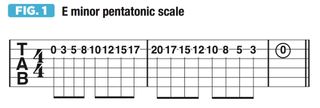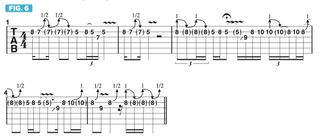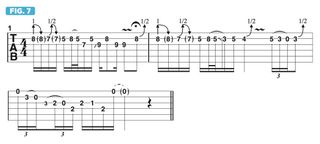Shake up your leads with these one-string bend techniques
Mastering precise bends on the B string can offer new ideas for pentatonic solos

In this next series of columns, I’d like to focus on string-bending techniques, playing on a variety of different string groups and moving through various keys.
Let’s start with the E minor pentatonic scale (E, G, A, B, D), played on the B string only. Before we address string-bending, let’s take a look at the scale as it lays on this one string.
As shown in Figure 1, we can start off with the open string, as B is one of the notes of E minor pentatonic, the 5th.
Starting from B, the ascending note series for E minor pentatonic is B, D, E, G, A, B, D, E, G. One can bend up to any of the notes in the scale, or bend back down to it from a pre-bend.

As demonstrated in Figure 2, the first fretted note on the B string is D, so we bend up to D from C#, located one half step and one fret below, and then release the bend back down to C#.
We then pull off to the open B string and finish off the phrase in a melodic way. I'm envisioning these licks as they might be played in a blues or rock tune, so the implied harmony is dominant 7th. With E as the tonic, the “home” chord is E7 (E, G#, B, D). This is why G#, the major 3rd of E, is included.

Figure 3 offers an example of bending down to D: I begin with a whole-step pre-bend, from D to E, then release the bend back to D and resolve the phrase with a standard blues lick in E. Experiment with different ways to bend back to D after first bending from D up to E.

The next available note in E minor pentatonic on the B string is E, so we can sound that note by either bending up to it from D, or bending down to it, as demonstrated in Figure 4.
We begin by applying a one-and-one-half-step pre-bend from E to G, then release the bend from back to E. On beats 3 and 4, I repeat the E-to-G bend, using it as a thematic melodic idea.

Another way to sound the E note is to bend up to it from a half step below, from D#, at the 4th fret. Although this note is outside the E minor pentatonic scale, it still “works” as an approach tone. This is shown in bar 1 of Figure 5. Try alternating between half- and whole-step bends, as illustrated with the whole-step bend in bar 2 of Figure 5.

The next note in the scale is G. So, as shown in bars 1 and 2 of Figure 6, we can bend up to that note from a half step below, from F#. We can also bend back to G from a pre-bend to A, as in bars 3-5 of this example.

In Figure 7, the same approach is taken for the next higher note in the scale, A.

Get The Pick Newsletter
All the latest guitar news, interviews, lessons, reviews, deals and more, direct to your inbox!
Guitar World Associate Editor Andy Aledort is recognized worldwide for his vast contributions to guitar instruction, via his many best-selling instructional DVDs, transcription books and online lessons. Andy is a regular contributor to Guitar World and Truefire, and has toured with Dickey Betts of the Allman Brothers, as well as participating in several Jimi Hendrix Tribute Tours.

Want to play Master of Puppets the right way? Here's how to get faster at downpicking so you can chug like James Hetfield

“A few poorly intonated sustained bends in a solo can make the guitar's most emotive technique sound bad”: Learning how to bend strings correctly is one of the quickest ways to make your playing sound better



![Joe Bonamassa [left] wears a deep blue suit and polka-dotted shirt and plays his green refin Strat; the late Irish blues legend Rory Gallagher [right] screams and inflicts some punishment on his heavily worn number one Stratocaster.](https://cdn.mos.cms.futurecdn.net/cw28h7UBcTVfTLs7p7eiLe-840-80.jpg)





